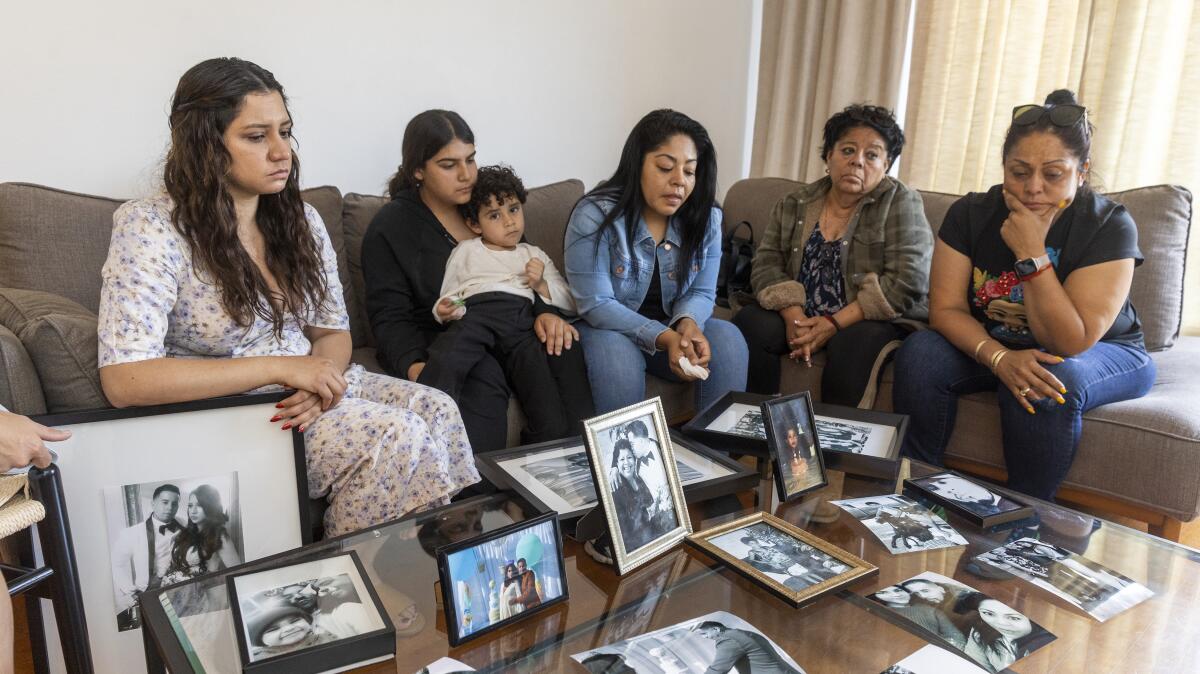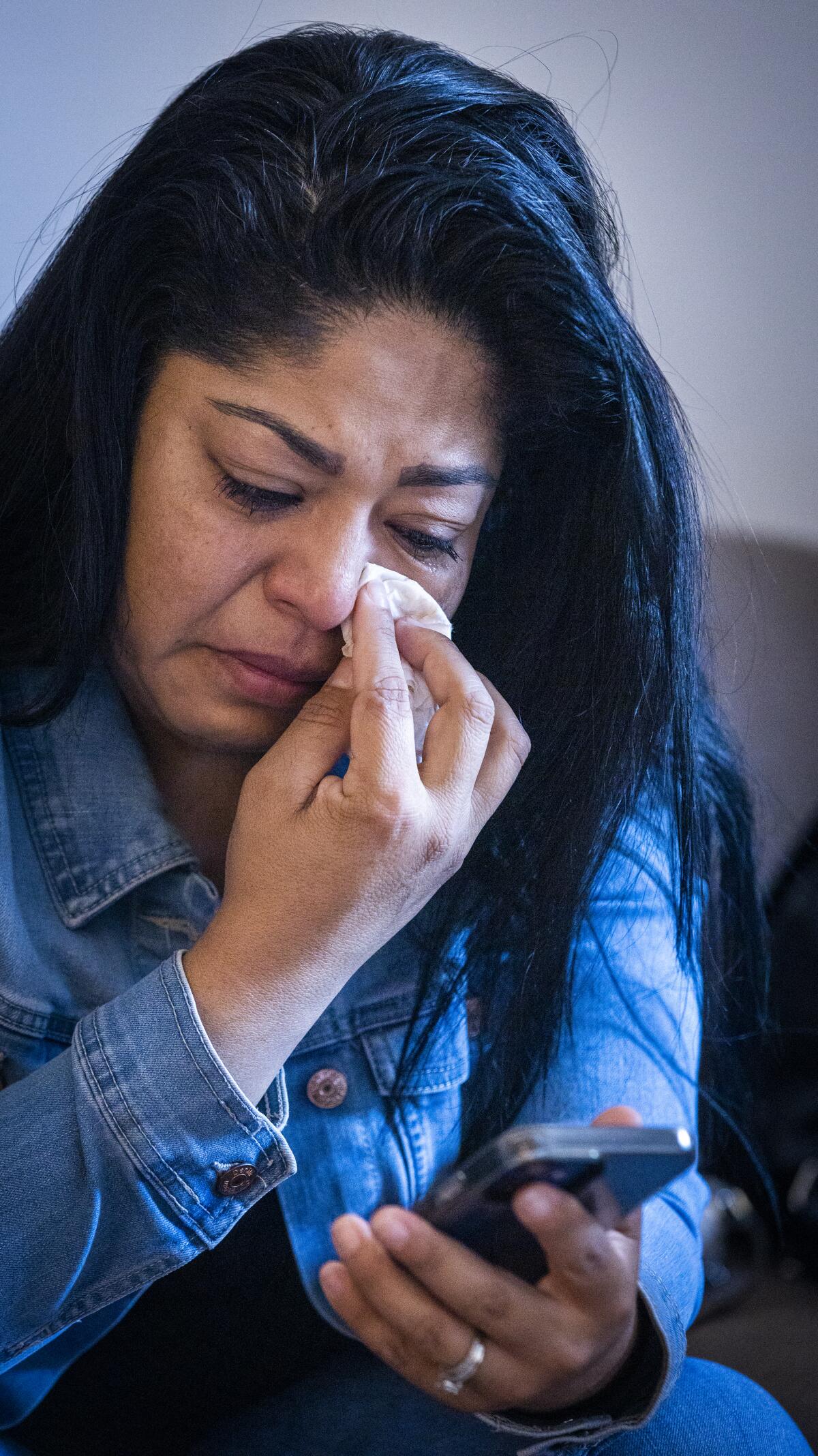A death and lawsuit bring more scrutiny to timing in LAPD shootings

- Share via
When Alan Castellanos began moving toward a team of Los Angeles police officers with a knife in his hand one afternoon in April, they seemed ready to hold him off without using deadly force.
Two officers had Tasers trained on Castellanos, another had a beanbag shotgun aimed at him and a fourth was armed with a 40-millimeter hard-foam projectile launcher.
Yet within seconds, Castellanos was on the ground with a fatal gunshot wound to the abdomen after a fifth officer shot him with his handgun just as another deployed a Taser.
For Castellanos’ family, the killing was incomprehensible — and inexcusable.
“They’re overreacting. They’re not planning,” Castellanos’ sister, Cristian Mendoza, said of the officers involved. “It makes it seem like they have no care for human life.”
“Clearly the LAPD didn’t do their job right. There could have been a better outcome,” said Castellanos’ wife, Nailea Vera Castellanos. “And it’s not the first time it’s happened.”

According to a recent Times investigation, Castellanos’ shooting was at least the eighth in the last two years in which groups of officers simultaneously fired handguns and weapons meant to avoid killing, such as projectile launchers or Tasers.
In each incident, the person they shot was armed with a knife or some other edged or blunt object, not a firearm. In many cases, they appeared to be mentally ill.
The shootings have raised increasing concern among LAPD officials who have said they are working to address the issue by retraining officers to hold off on using deadly force if possible until less-lethal options have been tried.
And shooting survivors and relatives of those killed have filed lawsuits challenging LAPD officers’ actions in such shootings. The decision to fire bullets before giving Tasers or nonlethal projectiles a chance to subdue a suspect is evidence of excessive force and poor oversight by the department, the lawsuits claim.
Last month, a federal judge ruled that an LAPD officer was personally liable for violating a homeless man’s rights when he shot the man in the street in Venice in 2019 despite being surrounded by other officers armed with less-lethal weapons.
U.S. District Court Judge Dolly Gee found Officer Jonathan Concetti responsible for excessive force, assault, battery and negligence in the shooting of John Penny, who was wounded in the Venice shooting but survived. Penny appeared to be in mental distress at the time, holding a wooden board and moving erratically around an alleyway.
Gee issued her ruling in a summary judgment early on in the proceedings. She rejected Concetti’s claim that the controversial judicial doctrine known as qualified immunity protected him from personal liability for actions on the job.
Gee concluded that Penny hadn’t committed a crime, wasn’t attempting to flee, had not attacked any of the officers at the scene and did not present an “imminent harm” to Concetti when the officer fired.
She also found that a supervisor had ordered the use of less-lethal weapons, which were available at the scene, and that the officers hadn’t warned Penny that he could be shot.
Gee noted as well that a large number of officers were present, greatly outnumbering Penny.
Based on those factors, Gee concluded, Penny “holding a wooden board and refusing to drop it” was not a justification for Concetti shooting him. The officer violated Penny’s constitutional rights, she ruled.
Concetti appealed the decision this week to the U.S. 9th Circuit Court of Appeals. His attorneys declined to comment, as did the city attorney’s office. A separate ruling by Gee on the actions of Concetti’s supervisor is also being appealed, while claims against other involved officers are set for trial.
Shaleen Shanbhag, one of Penny’s attorneys, said the ruling was an “unprecedented” victory for victims of police shootings and should be seen as a warning to both the LAPD and individual officers that, while each case is unique, the use of deadly force over less-lethal options will be scrutinized closely.
Denisse Gastélum, an attorney for Castellanos’ family, said she was studying the ruling in the Penny case closely as she and the family consider filing their own lawsuit against the city.
“What is this less-lethal for? For show? For appeasement? For some kind of check mark? Because clearly there’s not communication” about using the less-lethal weapons first, Gastélum said. “These less-lethal weapons are designed to control. Firearms are designed to kill. You use them at the exact same time, what’s going to happen? You’re going to kill.”
The LAPD identified the officer who shot Castellanos as James Galbraith. Dave Winslow, the officer’s attorney, said Galbraith “had no other choice but to shoot” after Castellanos moved rapidly toward him and his fellow officers at close range.
“If he didn’t shoot in that moment, he could have been stabbed, injured, killed,” Winslow said.
Winslow said the fact that officers used less-lethal and lethal force simultaneously was “not a failure of the planning” by the officers, but a “failure of the policy” of the LAPD — which precludes officers from shooting people with less-lethal weapons unless they present an “immediate threat of violence or physical harm” to officers.
That is essentially the same standard applied to the use of deadly force, Winslow said.
There were a few moments just before the shooting when Castellanos was farther away from the officers — and not as immediate of a threat — when it would have been “a perfect time” to hit him with projectiles or Tasers, Winslow said. But doing so would have violated LAPD policy, he said.
“The policy needs to be changed to allow the officers more discretion to use less-lethal before lethal is required,” Winslow said.
LAPD officials did not respond to a request for comment.
The shooting remains under investigation and has yet to come before the civilian L.A. Police Commission, which will rule on whether the involved officers’ actions violated department policy.
On a recent afternoon, Castellanos’ family members gathered on a couch around a wide coffee table where they spread out photos of Castellanos, whom they described as a doting son, a good husband, a loving father and a goofy sibling and uncle.
Castellanos worked in construction. He was trying to save money for his daughter’s quinceañera and he liked to prank call his family members. He helped get the family through the recent death of their eldest sister to cancer.
Mendoza, Castellanos’ sister, said the family still doesn’t know what was going on with her brother on the day he was shot, when a woman in an apartment called 911 to say a man was smashing windows outside and threatening her. But clearly he was “going through some sort of mental breakdown,” she said.

She expressed dismay that such an outcome could be acceptable in a city as large as L.A., where police encounter mentally ill people frequently.
“This time it was us, and it needs to stop here. Next time it could be anybody else’s family,” Mendoza said. “We shouldn’t be worrying about who’s next. That shouldn’t be a worry that anybody should have.”
More to Read
Sign up for Essential California
The most important California stories and recommendations in your inbox every morning.
You may occasionally receive promotional content from the Los Angeles Times.














